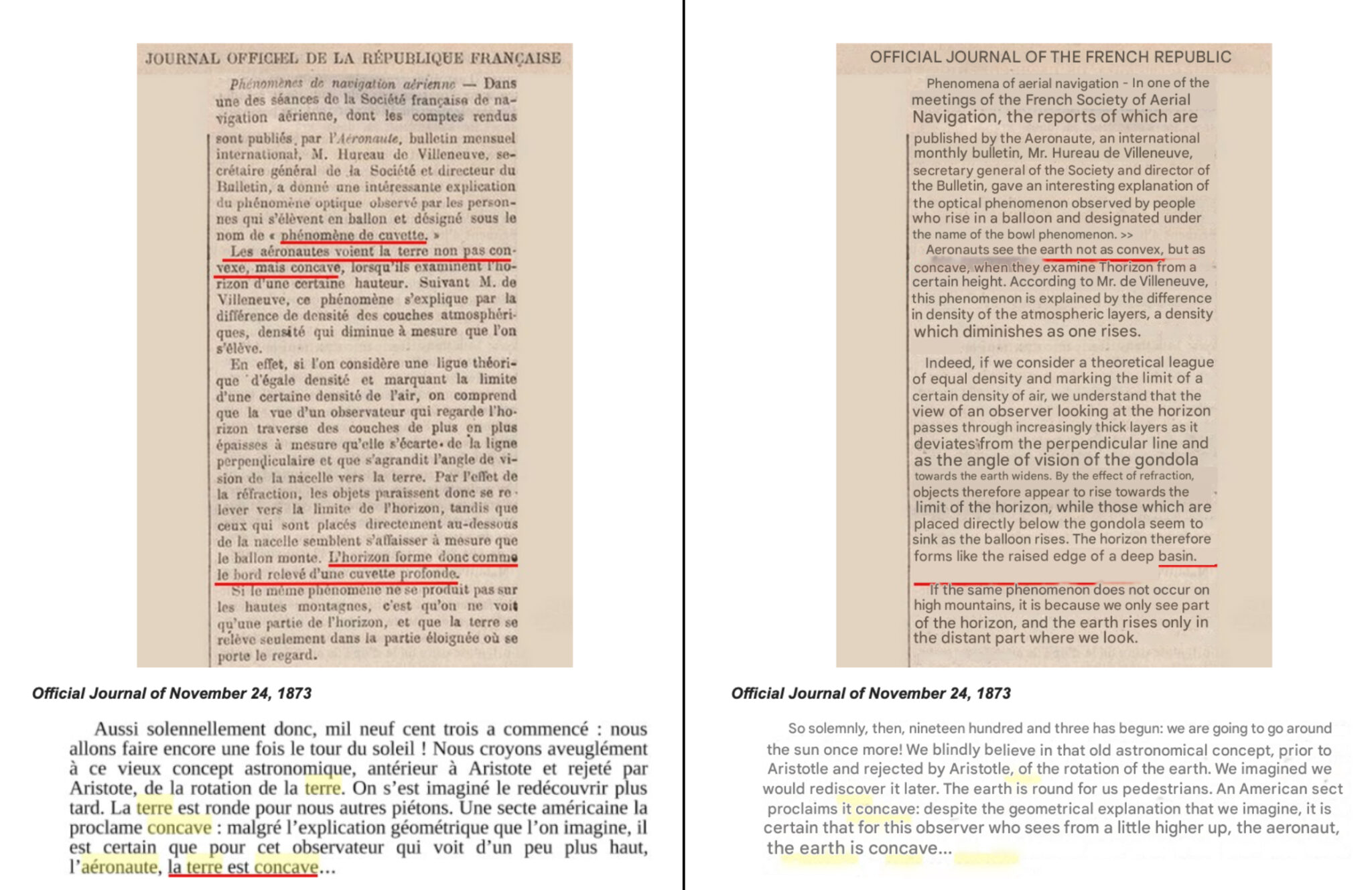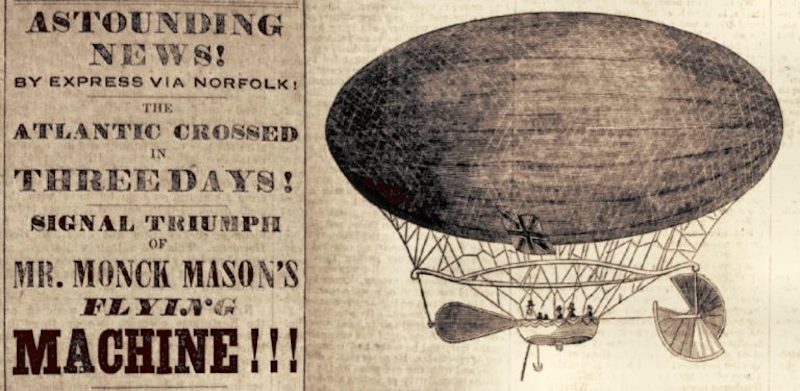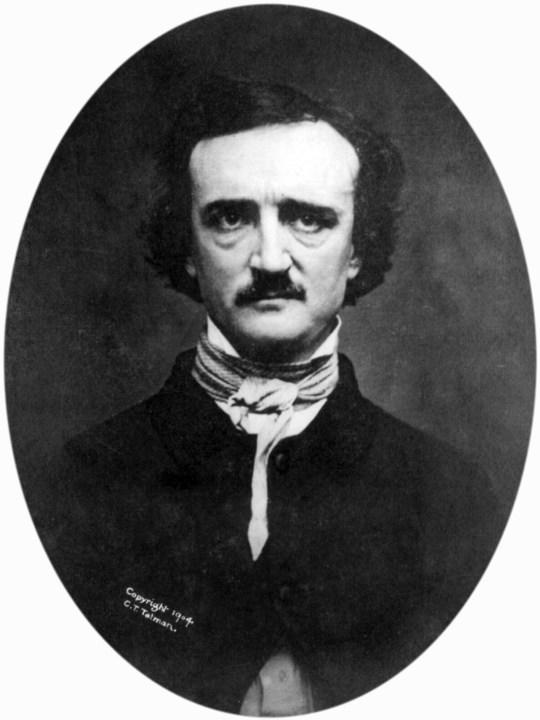Before the advent of aviation adventure seekers flew miles high in hot air balloons. These high altitude trips allowed aeronauts to observe the true nature of Earth without peering through the distorted nature of glass, windows, or a fish-eye lens. With the unaided eye they recorded their observations. Here are their testimonies.
“The apparent concavity of the earth as seen from a balloon. – A perfectly-formed circle encompassed the visibly; planisphere beneath, or rather the concavo-sphere it might now be called, for I had attained a height from which the earth assumed a regularly hollowed or concave appearance – an optical illusion which increases as you recede from it. At the greatest elevation I attained, which was about a mile-and-a-half, the appearance of the world around me assumed a shape or form like that which is made by placing two watch glasses together by their edges, the balloon apparently in the central cavity all the time of its flight at that elevation.”
– Wise’s Aëronautics
“Another curious effect of the aërial ascent was that the earth, when we were at our greatest altitude, positively appeared concave, looking like a huge dark bowl, rather than the convex sphere such as we naturally expect to see it… The horizon always appears to be on a level with our eye, and seems to rise as we rise, until at length the elevation of the circular boundary line of the sight becomes so marked that the earth assumes the anomalous appearance as we have said of a concave rather than a convex body.”
– Mayhew’s Great World of London
“The chief peculiarity of a view from a balloon at a consider-able elevation, was the altitude of the horizon, which remained practically on a level with the eye, at an elevation of two miles, causing the surface of the earth to appear concave instead of convex, and to recede during the rapid ascent, whilst the horizon and the balloon seemed to be stationary.”
– London Journal, July 18th, 1857
“I don’t know that I ever hinted heretofore that the aëronaut may well be the most skeptical man about the rotundity of the earth. Philosophy imposes the truth upon us; but the view of the earth from the elevation of a balloon is that of an immense terrestrial basin, the deeper part of which is that directly under one’s feet. As we ascend, the earth beneath us seems to recede–actually to sink away – while the horizon gradually and gracefully lifts a diversified slope, stretching away farther and farther to a line that, at the highest elevation, seems to close with the sky. Thus, upon a clear day, the aëronaut feels as if suspended at about an equal distance between the vast blue oceanic concave above and the equally expanded terrestrial basin below.”
– Mr. Elliott, an American balloon aëronaut, in a letter giving an account of his ascension from Baltimore.
“The plane of the earth offers another delusion to the traveler in air, to whom it appears as a concave surface, and who surveys the line of the horizon as an unbroken circle, rising up, in relation to the hollow of the concave hemisphere, like the rim of a shallow inverted watch-glass, to the height of the eye of the observer, how high soever he may be–the blue atmosphere above closing over it like the corresponding hemisphere reversed.”
– Glaisher’s Report, in “Leisure Hour,” for May 21, 1864.
“It seemed a flat disc with upturned edge”
– Auguste Piccard 1931
“The appearance which the earth presents when seen from a balloon is peculiar, and at a first view suggests anything but the idea of a convex surface such as a globe like the earth might be expected to present. The earth beneath the balloonist appears in fact like a gigantic basin, the rim of which is the horizon all round him, while its deepest part lies below him. Mr. Glaisher (I refer to the eminent meteorologist and aeronaut, not his logarithmic offspring, the Glaisher of Prime Factors, to whom the expansion of logarithms-Characteristic One—is of more interest than that of any balloon the world has yet seen) has spoken of this illusion, though of course he was in no sense deceived by it.*
Fig. 18 illustrates the peculiar effect in question; but I have added to the illusion affecting the aspect of the earth’s surface another, equally marked and much more familiar, affecting the aspect of the clouds.
The explanation of both peculiarities is the same. In my papers on Clouds and their Appearance I have shown how we are deceived into the idea that the clouds form a sort of dome over our heads, whereas the under surface of a layer of clouds, though slightly arched, is in reality very nearly flat within the range of view commanded by the eye. The eye is not sensible of the much greater distance separating us from the clouds near the horizon than from those overhead; and losing the effect of distance we picture the cloud-surface near the horizon as springing almost if not quite vertically from the earth’s surface, to arch over, gradually at first and more rapidly afterwards, towards the point overhead. When we view the under surface of clouds from a balloon situated as shown in Fig. 18, a similar effect is produced.
But also, and for precisely similar reasons, a similar effect is produced on the appearance of the earth’s surface below us. When we look directly down we see that the earth lies far below us, the greatness of the distance being very obvious and striking. On the other hand when we look towards the horizon, although the line of sight really is depressed slightly below the horizontal direction, the depression is not at all obvious, even when we are a mile or two above the sea-level.
Say for instance we are even so much as two miles above the sea-level.
Then from what has been already shown, the depression of the visual horizon (suppose it to be a sea horizon) below the true horizontal direction, corresponds to the angle subtended by four miles at the distance where the line of sight from a height of 2 miles touches the sea level.
This distance, neglecting refraction, which really increases it,* is represented in miles by sqrt(2×8000) or √16000, or by about 127 miles subtends less than 2 degrees, which to the eye appears but an insignificant angle.
Comparing unconsciously this slight depression of the horizon, with the obvious and startling depression of the earth’s surface underneath his car, the aeronaut is deceived into the impression that the surface underneath rises up all around him to his own level or nearly so,—in other words the illusion of a basin-shaped depression such as is shown in Fig. 18 is produced.
footnotes: Mr. Glaisher thinks the earth may have a concave surface — so that as the astronomer holds the earth to be convex while the aeronaut thus misrepresented-holds it to be concave.”
-Pretty Proofs of the Earth’s Rotundity by Richard A. Proctor (KNOWLEDGE – An Illustrated Magazine of Science Volume IV) [July to December 1883]
APPEARANCE OF THE EARTH VIEWED FROM A BALLOON.
All perception of comparative altitudes of objects on or near the ground is lost-houses, trees, the undulation of the country, &c., all are reduced to one level, and even the lower detached clouds appear to rest on the earth; everything, in fact, seems to be on the same level, and the whole has the appearance of a plane.
Everything seen, looking downwards from a balloon, including the clouds, seems projected upon the one visible plane beneath. Always, however great the height of the balloon, when I have seen the horizon it has roughly appeared to be on the level of the car-though of course the dip of the horizon is a very appreciable quantity-or the same height as the eye. From this one might infer that, could the earth be seen without a cloud or anything to obscure it, as that point of the plane beneath is directly under the eye, and the boundary line of the plane approximately the same height as the eye, the general appearance would be that of a slight concavity; but I have never seen any part of the surface of the earth other than as a plane. Towns and cities, when viewed from the balloon, are like models in motion. I shall always remember the ascent of the 9th October, 1863, when we passed over London about sunset. At the time when we were 7,000 feet high, and directly over London Bridge, the scene around was one that cannot probably be equalled in the world.”
-James Glaisher, Travels in the Air, (page 99) 1871
https://archive.org/details/Travelsair00Glai/page/98/mode/2up?q=concavity
Popular Scientific Recreations – Gaston Tissandier 1883
https://books.google.com/books?id=VidRAAAAYAAJ&pg=PA306&dq=%22aeronaut%22+concave&hl=en&newbks=1&newbks_redir=0&sa=X&ved=2ahUKEwiYoI3A9O-CAxUyBDQIHbXPBUYQ6AF6BAg0EAI#v=onepage&q=%22aeronaut%22%20concave&f=false
Knowledge Magazine – 1883
https://books.google.com/books?id=gLY_AQAAMAAJ&pg=PA275&dq=%22aeronaut%22+concave&hl=en&newbks=1&newbks_redir=0&sa=X&ved=2ahUKEwiYoI3A9O-CAxUyBDQIHbXPBUYQ6AF6BAgtEAI#v=onepage&q=%22aeronaut%22%20concave&f=false
The American Cyclopaedia: A Popular Dictionary of General Knowledge
– George Ripley, Charles Anderson Dana 1883
https://books.google.com/books?id=hUBMAAAAMAAJ&pg=PA150&dq=%22aeronaut%22+concave&hl=en&newbks=1&newbks_redir=0&sa=X&ved=2ahUKEwiYoI3A9O-CAxUyBDQIHbXPBUYQ6AF6BAgJEAI#v=onepage&q=%22aeronaut%22%20concave&f=false
The Cosmopolitan Magazine 1904
https://books.google.com/books?id=RzdDzWNvgqAC&pg=PA48&dq=%22aeronaut%22+concave&hl=en&newbks=1&newbks_redir=0&sa=X&ved=2ahUKEwiYoI3A9O-CAxUyBDQIHbXPBUYQ6AF6BAgcEAI#v=onepage&q=%22aeronaut%22%20concave&f=false
Bibliography of Aeronautics – U. S. National Advisory Committee for Aeronautics 1921
https://books.google.com/books?id=gTkpAAAAYAAJ&pg=PA488&dq=%22aeronaut%22+concave&hl=en&newbks=1&newbks_redir=0&sa=X&ved=2ahUKEwjvu-zK-e-CAxW0HjQIHZBRApk4MhDoAXoECBQQAg#v=onepage&q=%22aeronaut%22%20concave&f=false
^via https://laterreestconcave.home.blog/2019/01/19/la-concavite-de-la-terre-vue-dun-ballon/
This observation even made it into novels like A Dweller on Two Planets, by Phylos the Thibetan (Frederick S. Oliver), [1894]
In this passage the narrator Phylos is describing being aboard an advanced Atlantean aerial vessel — essentially a kind of anti-gravity airship that uses a “repulsion force” to fly at extreme altitudes. Notice how he describes the earth beneath him.
“In order that we might be wholly out of the range of the influence of the storm, I gave directions to rise above the level of the disturbance, if such a region of calm existed within reach, and there set the keys so as to stop all propulsion. Receiving this order, the conductor augmented the repulsion force by means of the levers of degree, and we rose steadily up, up, up–above the clouds, above the rush of the hurricane, into a clear, calm atmosphere, intensely cold, almost thirteen miles from the earth’s surface.
the keys so as to stop all propulsion. Receiving this order, the conductor augmented the repulsion force by means of the levers of degree, and we rose steadily up, up, up–above the clouds, above the rush of the hurricane, into a clear, calm atmosphere, intensely cold, almost thirteen miles from the earth’s surface.
Could we have had a view unobstructed by stormclouds, we were just about high enough to afford us a horizon of three hundred and fifty miles. Soon after this order I went to my room to bed. With the morning the storm had not decreased in fury; and occasional flurries in the air above us proved that the storm-area on the surface must be of vast extent.
The cold outside was too intense to consider, even for an instant, the opening of the deck; the sky was almost black in the depth of its blueness; the sun, shorn of much of its dazzling brightness, appeared strangely dim, and the stars were visible. The steady motion of the air-dispensers as their wheels and pistons worked to maintain the interior air at a normal pressure was painfully apparent in the awful stillness, while the fizz of the air escaping through the fine crevices around the windows and edges of the deck made such a noise that I ordered the setscrews tightened and the ventilator pipes opened.
Had the frost not hindered vision through the windows and, with the clouds, prevented a view of the earth’s surface, a sight most peculiar would have been presented. The view toward the extended horizon would have made the apparent union of earth and sky seem almost on a level with us; but directly beneath, the fun separation from the solid globe would have seemed, not like a ball but like a huge bowl, ornamented with landscape scenes in its interior.”
Edgar Allen Poe – The Balloon Hoax
The Balloon-Hoax by Edgar Allan Poe was a fictional story published as a matter of fact in the New York Sun newspaper in 1844.
The Hoax: The piece is Poe’s attempt at a hoax, similar to the 1835 Great Moon Hoax. It details, with great technical specificity, the supposed successful transatlantic voyage of the steering balloon “Victoria” in an “inconceivably brief period of seventy-five hours.”
The Voyage: A group of eight travelers, including noted aeronauts Mr. Monck Mason and Mr. Robert Holland, supposedly departed from North Wales and, after an unexpected gale, decided to aim for North America.
The Technology: The account meticulously describes the balloon’s construction, which was an ellipsoid that used coal gas (for cost and convenience), a newly-conceived Archimedean screw for propulsion, and a rudder for steering. It also details the function of the guide-rope invented by Mr. Green, which automatically helped maintain a stable altitude, making long-distance voyages possible.
The Conclusion: The journal-style narrative abruptly ends with the triumphant arrival of the “Victoria” at Sullivan’s Island, near Charleston, S.C.
The Retraction: The New York Sun later retracted the story, stating they were “inclined to believe that the intelligence is erroneous,” but praised the detailed and scientifically plausible writing.
Author of the Postscript: The entry is written by Mr. Harrison Ainsworth, one of the eight fictional passengers, on the second day of the voyage (Sunday, the seventh).
from the text:
“P.S. [By Mr. Ainsworth.] I have little to record, except the fact (to me quite a surprising one) that, at an elevation equal to that of Cotopaxi, I experienced neither very intense cold, nor headache, nor difficulty of breathing; neither, I find, did Mr. Mason, nor Mr. Holland, nor Sir Everard. Mr. Osborne complained of constriction of the chest—but this soon wore off. We have flown at a great rate during the day, and we must be more than half way across the Atlantic. We have passed over some twenty or thirty vessels of various kinds, and all seem to be delightfully astonished. Crossing the ocean in a balloon is not so difficult a feat after all. Omne ignotum pro magnifico (“Every unknown thing for magnificent.”). Mem: at 25,000 feet elevation the sky appears nearly black, and the stars are distinctly visible; while the sea does not seem convex (as one might suppose) but absolutely and most unequivocally concave.(1)”
“[1] Note.—Mr. Ainsworth has not attempted to account for this phenomena, which, however, is quite susceptible of explanation. A line dropped from an elevation of 25,000 feet, perpendicularly to the surface of the earth (or sea), would form the perpendicular of a right-angled triangle, of which the base would extend from the right angle to the horizon, and the hypothenuse from the horizon to the balloon. But the 25,000 feet of altitude is little or nothing, in comparison with the extent of the prospect. In other words, the base and hypothenuse of the supposed triangle would be so long when compared with the perpendicular, that the two former may be regarded as nearly parallel. In this manner the horizon of the aeronaut would appear to be on a level with the car. But, as the point immediately beneath him seems, and is, at a great distance below him, it seems, of course, also, at a great distance below the horizon. Hence the impression of concavity; and this impression must remain, until he elevation shall bear so great a proportion to the extent of prospect, that the apparent parallelism of the base and hypothenuse disappears—when the earth’s real convexity must become apparent.”
https://www.jasoncolavito.com/the-balloon-hoax.html
….Another from Poe
The Unparalleled Adventure of One Hans Pfaall by Edgar Allen Poe
“April 7th. Arose early, and, to my great joy, at length beheld what there could be no hesitation in supposing the northern Pole itself. It was there, beyond a doubt, and immediately beneath my feet; but, alas! I had now ascended to so vast a distance that nothing could with accuracy be discerned. Indeed, to judge from the progression of the numbers indicating my various altitudes respectively at different periods between six A.M. on the second of April and twenty minutes before nine A.M. of the same day (at which time the barometer ran down), it might be fairly inferred that the balloon had now, at four o’clock in the morning of April the seventh, reached a height of not less, certainly, than 7,254 miles above the surface of the sea. This elevation may appear immense, but the estimate upon which it is calculated gave a result in all probability far inferior to the truth. At all events, I undoubtedly beheld the whole of the earth’s major diameter; the entire northern hemisphere lay beneath me like a chart orthographically projected, and the great circle of the equator itself formed the boundary line of my horizon. Your Excellencies may, however, readily imagine that the confined regions hitherto unexplored within the limits of the Arctic circle, although situated directly beneath me and therefore seen without any appearance of being foreshortened, were still, in themselves, comparatively too diminutive and at too great a distance from the point of sight to admit of any very accurate examination. Nevertheless, what could be seen was of a nature singular and exciting. Northwardly from that huge rim before mentioned, and which, with slight qualification, may be called the limit of human discovery in these regions, one unbroken, or nearly unbroken, sheet of ice continues to extend. In the first few degrees of this its progress, its surface is very sensibly flattened, farther on depressed into a plane, and finally, becoming not a little concave, (in other words quite noticeably concave) it terminates, at the Pole itself, in a circular centre, sharply defined, whose apparent diameter subtended at the balloon an angle of about sixty-five seconds, and whose dusky hue, varying in intensity, was at all times darker than any other spot upon the visible hemisphere and occasionally deepened into the most absolute and impenetrable blackness. Farther than this, little could be ascertained. By twelve o’clock the circular centre had materially decreased in circumference, and by seven P.M. I lost sight of it entirely, the balloon passing over the western limb of the ice and floating away rapidly in the direction of the equator.”
Camille Flammarion (French astronomer and balloonist)
In Voyages Aériens (1870s), Flammarion wrote that balloons create the impression of a hollow Earth below:
“At high elevations the horizon seems lifted and the ground below [seems] to curve inward, like the interior of a vast bowl.”
He made this illustration you’ve seen, from 1888.
Discover more from JoeDubs
Subscribe to get the latest posts sent to your email.












These guys were kids in a lolly shop!